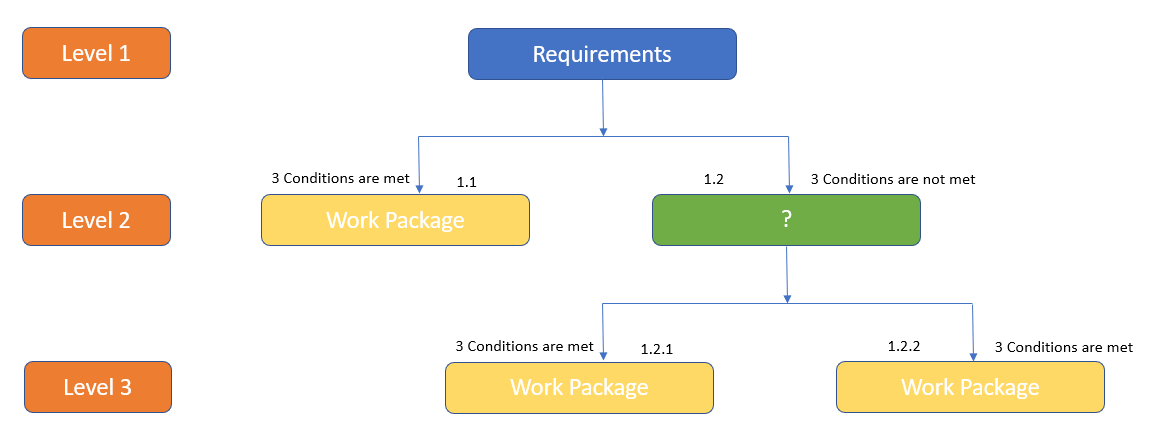
Project Scope Management
Project Scope Management is the PMP Knowledge Area. Purpose of Project Scope Management:
- To perform the work necessary to achieve project objectives. Caution: Only the work necessary.
- Here we finalize requirements, scope statement, WBS, WBS Dictionary to finalize scope baseline.
- We validate scope and control scope.
Processes & Outputs
| Process | Output |
| Plan Scope Management [Planning] | Scope Management Plan, Requirements Management Plan |
| Collect Requirements [Planning] | Requirements Documentation, Requirements Traceability Matrix |
| Define Scope [Planning] | Scope Statement |
| Create WBS [Planning] | WBS, WBS Dictionary, Scope Baseline [Contains approved scope statement, WBS, WBS Dictionary] |
| Validate Scope [Monitoring and Controlling] | Accepted Deliverable |
| Control Scope [Monitoring and Controlling] | We check scope performance and manage changes to the scope |
Process Description
1. Plan Scope Management [Process / Planning] – We develop Scope Management Plan, in which we describe how we will plan, implement, validate and control scope. When someone joins the project where some work has already been done and wanted to know procedures for planning, implementing, validating and controlling scope then he/she has to consult Scope Management Plan.
a. Requirements Documentation
b. Requirements Traceability Matrix
a. Interviews
b. Focus Groups – Involves collecting requirements from pre-selected key stakeholders.
c. Facilitated Workshops – It is a technique to remove differences and bring consensus. It is used when the stakeholders have differences in the requirements. It requires qualified facilitator. Example – Joint Application Development or Design (JAD), Quality Function Deployment (QFD).
d. Prototyping – Here the requirements are collected through iteration of “Mock-ups”. It is the tangible technique and better than interviews.
e. Observation or Job shadowing – When a project involves complex processes and finds difficulty in articulating the requirements. We can bring client to an area where we are doing similar job. We request the client to observe. This observation or job shadowing help the client to articulate the requirements.
f. Surveys or Questionnaires – It is used when the number of stakeholders is too large.
g. Documents Review
h. Creativity techniques – Example brainstorming
i. Context Diagrams
j. Benchmark – It means comparing our practices with those of other industries to gain ideas of improvement and to set new benchmark for performance. Here we compare our practices of collecting requirements with those of other industries in order to improve.
k. Decision Making Techniques – It is used for finalizing requirements like majority, consensus, dictatorship
a. Product Scope Description – All the features and functions of the product to be delivered.
b. Acceptance Criteria
c. Project Deliverable – These are major deliverable. We divide them further for creating WBS. Therefore, these deliverable make first level of WBS.
d. Project Exclusions – It will help us clarify expectations.
e. Constraints – Related to scope, time, cost, quality. Examples – Pre-defined budget, Funding limitations, imposed date and milestones.
f. Assumptions – Any factor that we consider to be true or certain for the sake of planning without proof or evidence is called assumption. We should record all our assumptions and check their validity during risk identification because all assumptions carry a degree of risk.
b. Expert Judgement
c. Facilitated Workshops – To remove differences and bring consensus on the contents of the scope statement.
d. Alternative generation – We invite creative ideas to generate alternative approaches for doing the project. There are 2 popular ways of inviting creative ideas: Brainstorming and Lateral Thinking [Given by Edward de Bono in the book “Six Thinking Hats”].
a. Realistic estimation or Reliable estimation
b. Work assignment
c. Monitoring and controlling of work
a. Scope Statement
b. WBS
c. WBS Dictionary
a. It helps us locate the level of the component in the WBS.
b. It provides framework for summing up resource information and cost information. It is used in bottom-up estimation of resource and cost.
a. We keep on dividing until it can be estimated reliably.
b. We keep on dividing until it becomes of assignable size.
c. We keep on dividing until it come to a level where we can monitor and control the work efficiently.

Tips:
a. WBS creation is the team effort.
b. WBS should be communicated to all stakeholders and their consent should be obtained because WBS becomes foundation for all estimation and planning.
c. WBS contains total project scope
d. Work not in WBS is outside the project
e. WBS is not the bar chart or bill of materials or organizational breakdown structure.
5. Validate Scope [Process / Monitoring and Controlling] – We formalize acceptance of completed deliverable ( after tested by Quality Control). Formal acceptance is provided by the customer or sponsor. Main purpose of the scope validation is to obtain formal acceptance of completed deliverable from the customer or sponsor. Whenever a deliverable is not acceptable then a change request is generated for corrective action.
Note: The purpose of the Quality Control is different from Scope Validation because the purpose of Quality Control is to check the correctness. Normally, Quality Control is performed before Scope Validation. Sometimes, both can be performed in parallel.
Techniques: Main technique is inspection which is also called review, audit or walk through.
Workaround is response to new risk. Workaround is developed in Monitor Risk process.
6. Control Scope [Process / Monitoring and Controlling] – We check scope performance and manage changes to the scope.
Concept of Monitoring and Controlling:
a. Check performance against plan or baseline by conducting variance analysis
b. Manage changes
Exercise: Answer at-least 80% of the questions correctly in order to master the topic.
20 Questions Challenge
50 Questions Challenge
